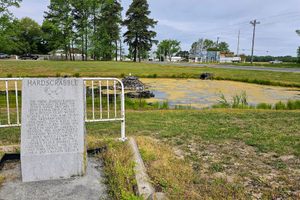About
Long a holiday staple of American Thanksgiving dinners, in the early 20th century, a sweet potato craze had swept the nation. In Delaware, the sweet potato was king, becoming the state’s staple agricultural product for a time. Although the industry has since declined essentially to extinction, reminders of these glory days of sweet potato farming can be found in a few otherwise plain-looking historic buildings known as “potato houses,” which are scattered around Sussex County in the southwest corner of the state.
As early as the 1860s, Delaware was seen as a potential hotbed of sweet potato cultivation. The sandy Sussex County soil and mild climate led to sweet potatoes that were grown with unusual richness and sweetness when compared to those grown in the Carolinas or Texas. Varieties were grown with names such as Big and Little Stem (for pies), or Nancy Hall, Hayman, or Southern Queen (for the kitchen table).
The demand was also growing. By 1909, the nation’s sweet potato crop had grown by more than 75 percent over the past 30 years. Most of the nation’s sweet potatoes were grown in the American South. However, with its proximity to major markets, Delaware could hold its own, ranking as high as 14th among states in sweet potato production, a massive figure given its tiny size. There was only one problem—timing.
In Delaware, sweet potatoes would generally be harvested in October, but they were most valuable during the holiday season. Therefore, these tubers would need to be kept at a steady temperature of 50 degrees Fahrenheit to avoid freezing in the cold or rotting from excessive warmth or moisture.
A series of plain-looking buildings known as potato houses began to pop up across Sussex County. They were usually tall and narrow, with a chimney that allowed them to be heated by a coal or wood-burning stove. They would be well-insulated, with over three layers of siding, which allowed them to retain warmth. And most of all, they were carefully ventilated, with tall arched roofs that allowed air to circulate and dissipate, preventing the building from overheating, even while the stoves burned all winter long.
Unfortunately, the houses were under constant threat of fires that would wipe out the season’s crop. Even worse, in 1940, black rot disease came to Delaware. The state’s sweet potato crop would be devastated. By that time, many Delaware farmers had taken stock of this clucked-up situation and pivoted towards raising broiler chickens, which Delaware is known for to this day.
With that, the era of sweet potato farming had come to an end, and potato houses were seen as eyesores, depressing land value in the county. Some were repurposed, but many more were torn down. By 1990, only about a dozen potato houses remained, and the ones that were in the best condition were placed on the National Register of Historic Places at the time.
In that sense, the Hearn Potato House is less an exceptional building in its own right, and instead one of the few survivors from a different time. Even some of the dozen landmarked buildings have since been removed or renovated, and it is now one of the best-preserved examples of the era. Built around 1900, the Hearn Potato House includes many of the features common to potato houses of that era—a tall, narrow frame with a gable front structure, thick triple-insulated walls, hinged window vents, and a trap door leading to the roof. Although in poor condition overall, it is now one of the best reminders of the days when Thanksgiving plates were filled with Delaware sweet potato pie.
Related Tags
Know Before You Go
The Hearn Potato House is located near a public gravel road in rural Delaware. If you are visiting, please be mindful that the potato house itself is located on private property, in an area that is rarely visited by outsiders. Obviously, do not enter the potato house or otherwise access any private area, and be ready to explain your whereabouts to neighbors.
A few other Sussex County Potato Houses remain standing, although their ranks continue to dwindle. As an alternative, the Phillips Potato House has recently been restored, if you would like to view a potato house in better condition.
Community Contributors
Added By
Published
November 27, 2024
Sources
- https://www.delmarvanow.com/story/news/local/delaware/2016/01/21/potato-houses/79109608/
- Colbert, Judy. It Happened in Delaware. United States: Globe Pequot, 2013.
- https://davetabler.com/souring-on-sweets-how-delawares-sweet-potato-empire-crumbled/
- https://npgallery.nps.gov/NRHP/GetAsset/NRHP/64500091_text
- https://npgallery.nps.gov/GetAsset/a17403ea-440a-41b8-a6e3-3e426a6e3fb1

























